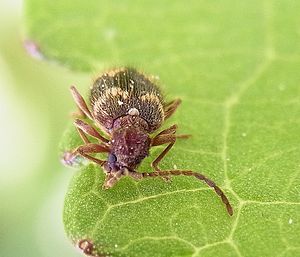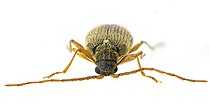Red-legged thief beetle
| Red-legged thief beetle | ||||||||||||
|---|---|---|---|---|---|---|---|---|---|---|---|---|

Females cleaning antennae |
||||||||||||
| Systematics | ||||||||||||
|
||||||||||||
| Scientific name | ||||||||||||
| Ptinus rufipes | ||||||||||||
| Olivier , 1790 |
The red-legged thief beetle ( Ptinus rufipes ) is a beetle from the family of the rodent beetle and the subfamily of the thief beetle . The genus Ptinus is represented in Europe with six sub-genera. The red-legged thief beetle belongs to the subgenus Bruchoptinus , which counts eleven species in Europe .
The beetle is not endangered and not protected, but neither is it harmful.
Notes on the name
The male was first described by Olivier in 1790 under the scientific name Ptinus rufipes , which is still valid today for the species . The short Latin description, consisting of seven words, ends with the words antennis pedibusque rufis ( Latin with red antennae and legs). This explains the species name rūfipes from Latin rūfus, red, and pēs. Leg. The German part of the name Rotbeinig is the rarely used translation of the scientific species name. The legs are also more reddish brown than red.
The female was described by Illiger in 1798 under the name Ptinus elegans as the 4th species of the genus Ptinus . Illiger realized that the specimen available for description was a female, but he was not aware that it was the female of rufipes . He listed Ptinus rufipes as the 2nd species of the genus, but at the same time noted in his description of Ptinus elegans that he was not aware of the male of Ptinus elegans , although he had already seen twelve females. The species name élegans (Latin) means fine, tasty .
The genus Ptīnus was established by Linné in 1767 as the 192nd genus. From the description of the genus it is not clear what the generic name refers to. After Schenkling is from Altgr. πτηνός “ptenós” for “feathered” derived and justified by the fact that the beetle Ptilinus pectinicornis , the feathered antennae, was counted by Linne to the genus Ptinus .
Description of the beetle
Males and females have different shapes, colors and hairs. Both are three to 4.5 millimeters long, have their heads tucked under, have long, eleven-segmented antennae that are turned in close together, a rounded pronotum that is pinched off at the base and shows four adjacent humps near the front edge, red-brown antennae and legs and five-segmented ones Tarsi , the fourth limb of which is finely lobed and slightly wider than the third limb (Fig. 3).
The upper lip (Fig. 6 left) is much wider than it is long, has entire margins and is hairy in front of it, arching forward. The upper jaw (Fig. 6 center) is thick and three-sided with a tooth on the cutting edge. The jaw button is shown with the lower jaw in Figure 6 and tinted green on the left in Figure 5. The lip switch is shown together with the second lip switch in Figure 6 on the right and tinted blue in Figure 5.
In the male (Fig. 1) the body is narrow and elongated. The wing covers are approximately cylindrical together with the abdomen, the sides widen only slightly towards the rear. The body is black to brown-black, but appears almost monochrome light gray-brown because of the short gray hair on the top. Only the small label is lighter and due to the alignment of the slightly longer hairs on the cusps, they appear a little more vividly colored.
The feelers consist of elongated members, which from the third member onwards are increasingly elongated and cylindrical. The middle links are more than three times as long as they are wide. The antennae are almost body length and hairy gray-brown, especially towards the base.
The pronotum is as wide as the head. It is almost cylindrical and a little longer than it is wide. The base is cut off. The pronotum has a deep longitudinal groove and on each side of it a groove that is less deep. The inner channel is separated from the outer channels by a wall. The outer grooves are followed by a further elevation at the front towards the outside, so that the pronotum has four elongated blunt humps next to each other, which are emphasized by stiff, short brooches.
The elytra are wider than the pronotum. The shoulder corners are square. Recessed points form straight longitudinal rows, but the rows of points are made indistinct by the hair.
The female (Fig. 2) looks darker than the male. The elytra are elongated oval with rounded shoulders. The basic hair is yellowish to dark and more protruding than in the male, which is why it hides the body color less. White hairs lying flat form two cross bands on the elytra and a small spot at the end of the elytra.
The antennae are shorter than the body and more hairy than the male.
The pronotum also has four humps, but is almost spherical, the hairiness of the humps is more pronounced than in the males. The middle cusps are shorter and as high as the outer cusps and are closer to the front edge than the outer cusps.
The tag is also hairy a little lighter.
The elytra are elongated oval and strongly arched. The rows of dots are clearly visible because of the poor coverage of the basic hair. The anterior white-gray band is just behind the first quarter of the length of the wing cover. It is narrow, the elytra seam bent down forward and outward reaches the wing margin ceiling. The second transverse band is behind the middle and forms a zigzag. Between the two bandages, the elytra appear a little darker than in front and behind because the basic hair is darker.
An inconspicuous but unusual feature of the female can be found on the underside of the abdomen. In the middle of the fourth abdominal segment there is a punctiform dimple (green arrowhead in Fig. 4). Two fine, long and protruding bristles spring from this.
biology
The species is found in sparse deciduous forests, parks, on forest edges and hedges. The larva develops in fungus wood with white rot , especially beech and hornbeam , but also in other deciduous trees, old fence posts and dry vine wood . The beetle appears from the end of May and develops at least two years.
distribution
The species is found in almost all of Europe, it is only absent on Iceland , Portugal and most of the Mediterranean islands. In Central Europe, the beetle is one of the most common species in the wild, but it is absent in higher mountain regions.
literature
- Heinz joy , Karl Wilhelm Harde , Gustav Adolf Lohse (ed.): The beetles of Central Europe . tape 8 . Teredilia Heteromera Lamellicornia . Elsevier, Spektrum, Akademischer Verlag, Munich 1969, ISBN 3-8274-0682-X , p. 67 f .
- Klaus Koch : The Beetles of Central Europe Ecology . 1st edition. tape 2 . Goecke & Evers, Krefeld 1989, ISBN 3-87263-040-7 , pp. 281 .
- Gustav Jäger (Ed.): CG Calwer’s Käferbuch. 3. Edition. K. Thienemanns, Stuttgart 1876, p. 391.
Individual evidence
- ↑ Ptinus rufipes in Fauna Europaea. Retrieved March 4, 2016
- ^ Ptinus at Fauna Europaea. Retrieved March 4, 2016
- ↑ Bruchoptinus (subgenus) in Fauna Europaea. Retrieved March 4, 2016
- ↑ a b c Sigmund Schenkling: Explanation of the scientific beetle names (species)
- ↑ a b W. F. Erichson u. a .: Natural history of Germany's insects Coleoptera 5th volume, 1st half Berlin 1898 p. 61
- ↑ a b J.G.Kugelann, J.Ch.Hellwig, JkW Illiger: Directory of Beetles in Preussens Halle 1798. Preview in the Google book search
- ^ Carolus Linnaeus: Systema Naturae .... 1st volume, part 2, 12th edition, Stockholm 1767 p. 565
- ↑ Sigmund Schenkling: Explanation of the scientific beetle names (genus)
- ↑ Otto Wünsche: The most widespread beetles in Germany 1895 preview in the Google book search
- ↑ M. Olivier: Entomologie ou Histoire Naturelle des Insectes Coleoptères Tome II Paris 1790 p. 132: 7 17th genus, p. 8 or [1]
- ↑ key Ptinus at coleo-net
- ↑ Distribution map at Fauna Europaea ( memento of the original from March 10, 2016 in the Internet Archive ) Info: The archive link was inserted automatically and has not yet been checked. Please check the original and archive link according to the instructions and then remove this notice.














